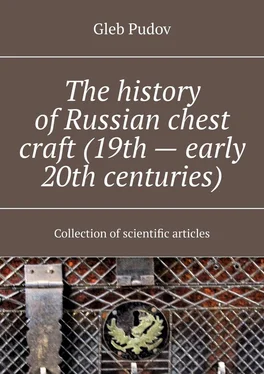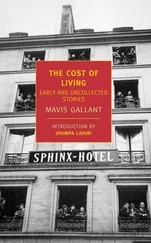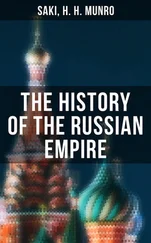The history of Russian chest craft (19th – early 20th centuries)
Collection of scientific articles
Gleb Pudov
Reviewer Alexej Chevardin
Reviewer Irina Kolobkova
Editor Natalia Kovaleva
© Gleb Pudov, 2022
ISBN 978-5-0056-3717-8
Created with Ridero smart publishing system
The chest has been known in Russia since ancient times. Even in the annals and Novgorod birch bark letters there are references to chests and caskets. Many of them are admirable works of art. By the 19th century, Russian chest craft had turned into a powerful industry, in which hundreds of craftsmen were employed.
The history of chest production has been little studied until recently. There were only a few scientific articles and small notes in local newspapers. However, the situation has recently changed: monographs have been published in the major centers of chest production in Russia, as well as many scientific articles, the conclusions of which are based on previously unknown archival information. These works deal with many aspects of the chest production: the history of specific workshops, branding features, the specifics of certain types of chests and caskets, biographies of people who explored the craft in the 19th century, etc. But all of them were published in Russian and are known only to a narrow circle of local specialists. For foreign researchers, the history of Russian chest production remains terra incognita. Until now, information about it has hardly gone beyond the geographical borders of Russia.
This edition is the first attempt to «cut a window to Europe». As soon as the book is available in foreign libraries, it will enable Western scholars to get acquainted with the history of the Russian chest.
Gleb Pudov summarized the experience of many years of research on chest production in Russia in his monograph. The sections of the book present and analyze the activities of various Russian centers of the production of chests in the 19th – early 20th centuries (Russian North, Urals, Murom district, Vyatka province, local centers of craft). The illustrative material makes the author’s assertions convincing.
The main conclusions of the study are substantiated by extensive historiography and a large set of sources (archival data, museum specimens and field surveys of preserved objects).
After being acquainted with this book a foreign reader will get an idea about the Russian chest industry. It will become apparent that the products of each center had differences. They were evident in the appearance of chests and caskets. In his monograph Gleb Pudov emphasizes that the masters were the bearers of the traditions that had developed in a particular region. Therefore, as a rule, the artistic design of their products coincided with the products of other handicraftsmen: manufacturers of painted trays, wooden utensils, etc. The chest makers used materials and techniques that were widespread in their region, guided by the preferences of representatives of specific social strata.
So, in the eyes of the European reader, the Russian chest can appear not only as a local artistic phenomenon, but also as part of the world arts and crafts.
Natalia M. Shabalina,Doctor of Arts, Professor, South Ural State Humanitarian-Pedagogical University (Chelyabinsk, Russia); e-mail: nat.shabalina@mail.ru
The Russian chest is a wonderful artistic phenomenon. However, it is not well studied. There are many lacunae related to one or another particular chest production.
The proposed book consists of 15 scientific articles devoted to different aspects of the chest craft. What is the peculiarity of this collection? Firstly, not all of the author’s works on the history of the production of chests were included in it, but only those characterizing any aspects of it. Secondly, the articles are arranged not according to the time of writing, but according to the chronology of the chest production in Russia and the importance of one or another center for the general history of the craft. Thirdly, it took into account where the paper was published. Preference was given to less accessible to the reader works (for example, from collections of regional museums or universities). All articles have been corrected and supplemented in accordance with the current level of knowledge of Russian chest production, some are published in abbreviations.
It is unlikely that the author managed to avoid repetitions. There is a certain range of sources on the history of the chest craft of one or another region today. Addressing them inevitably leads to repetitions of certain facts, surnames, statistical information, etc. The author expresses the hope that the reader will duly understand it.
The history of the Russian chest has not been written yet. This publication is, in a sense, a preparatory work for a large generalizing book on the history of chest production in Russia. It only outlines the main points and sets the main accents. Perhaps, this will serve as a support for future researchers.
I’m grateful to Anna Kuznetskaya, a teacher and a linguist, for the assistance.
Russian-scandinavian artistic relations in chest production
The problem of interaction of craft traditions in the production of chests 1 1 The word «chest» in this article means not only the specific type of products of the chests master, but also the whole range of their products: usually consisting of two compartments: upper and lower skrynyas (the difference between a skrynya and a casket is that it has shelves inside), chests, podgolovnik, boxes, trunks, etc. A chest is characterized by some vagueness of terminology. In addition, geographical restrictions are expedient: the article deals mainly with products from the North-West and the Center of Russia. Chest products in the South and East of the country had slightly different forms and principles of decoration. And, finally, this work analyzes items made only by Russian craftsmen (by origin).
is of great importance when examining their artistic style. However, little attention has been paid to it until now. In the scientific literature, from time to time, there are only indications of the generality of the forms of Russian and foreign chest products 2 2 Гончарова Н. Н . Влияние православной культуры на содержание сюжетной росписи сундуков XVII—XVIII вв. // Народное искусство: русская традиционная культура и православие, XVIII—XXI вв.: традиции и современность. – М.: Союз Дизайн, 2013, С. 485; Пудов Г. А. Уральские сундуки XVIII—XX веков: история, мастера, произведения. – СПб.: Первый класс, 2016, С. 70; Пудов Г. А. О сундуках и шкатулках из коллекции отдела народного искусства Русского музея // Петербургские искусствоведческие тетради. Статьи по истории искусства. – Вып. 38. – СПб.: АИС, 2016, С. 138.
. As a rule, that’s as far as it, and, moreover, most often we mean Western European, not Scandinavian items.
The purpose of this article is to identify the results of the interaction of Russian and Scandinavian artistic traditions in chest production, to determine the role and significance of foreign influences on formation of Russian chest products style. The task is to analyse the artistic style, construction and materials of specific works from the collections of Russian and Scandinavian museums. While working on the topic, information from domestic and foreign special literature was used.
Читать дальше












